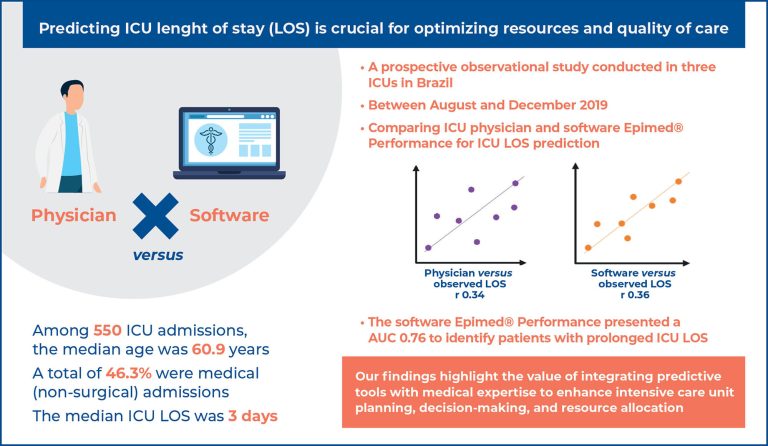einstein (São Paulo). 25/nov/2025;23:eAO1265.
Predicting intensive care unit length of stay: comparing physician assessments with software predictions in a multicenter study
DOI: 10.31744/einstein_journal/2025AO1265
Highlights
■ The sample included 555 patients from three hospitals (both public and private), representing diverse care settings.
■ Physician and software predictions showed moderate correlation with observed intensive care unit length of stay, highlighting limitations in absolute prediction accuracy.
■ Categorizing length of stay into time periods (<2, 2-5, >5 days) improved prediction accuracy to approximately 60% for both physicians and Epimed Monitor Performance®.
■ Epimed Monitor Performance® identified patients at risk of prolonged intensive care unit stay with an AUC of 0.76, sensitivity of 66.6%, and specificity of 74.2%.
■ Epimed Monitor Performance® can complement clinical judgment, supporting efficient intensive care unit planning and management.
ABSTRACT
Objective:
To compare the predictive abilities of medical professionals and the Epimed Monitor Performance© (EMP) software for intensive care unit length of stay and to assess EMP software effectiveness in identifying patients at risk of prolonged stays.
Methods:
This prospective multicenter observational study was conducted in three Brazilian intensive care units, enrolling adult patients admitted between August and December 2019. Data were collected using the Epimed Monitor System©. Both physicians and the EMP system predicted intensive care unit length of stay.
Results:
A total of 555 patients were included. The median age was 63.3 years (IQR=48.3-74.3), and 58.5% were males. Comorbidities were present in 72%, with 37.2% having cancer. The median intensive care unit length of stay was 3 days (IQR=2-6). Observed length of stay showed a correlation of 0.34 (p<0.001) with physician prediction and 0.36 (p<0.001) with EMP. Categorizing the length of stay improved the predictive performance by 60% for both methods. EMP demonstrated good accuracy in identifying patients at risk of prolonged stay (AUC: 0.76; 95%CI=0.70-0.81).
Conclusion:
Absolute prediction of intensive care unit length of stay remains challenging, but period categorization is a viable alternative. EMP aids in identifying patients at risk of prolonged stays and thus can complement clinical judgment. Our findings highlight the value of integrating predictive tools with medical expertise to enhance intensive care unit planning, decision making, and resource allocation.
[…]
6



